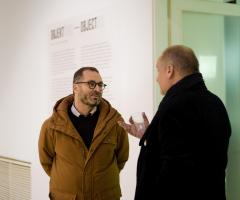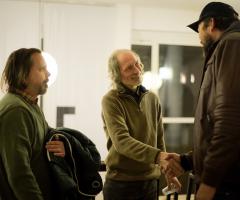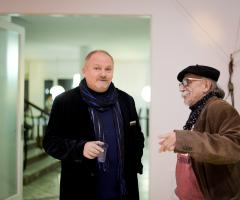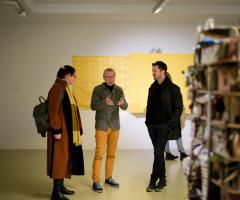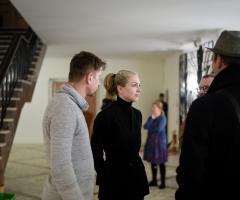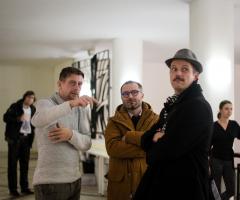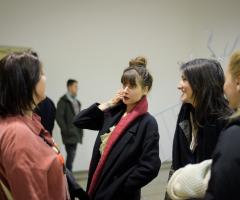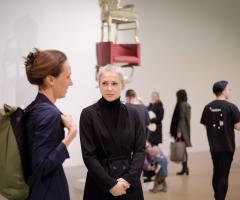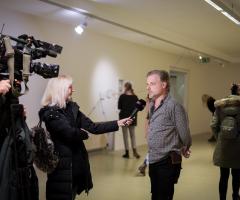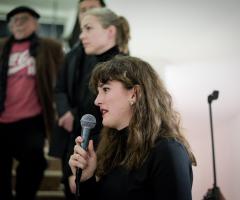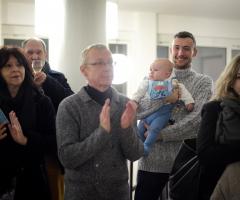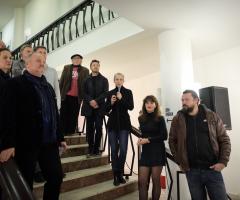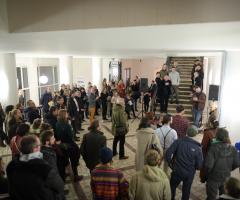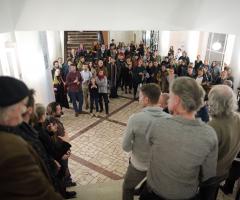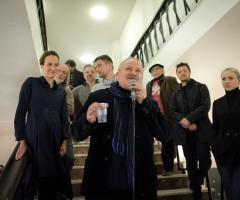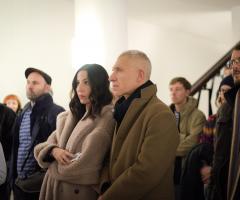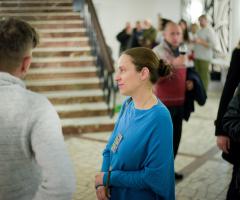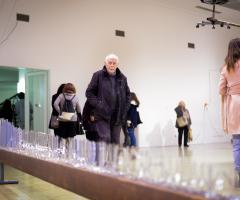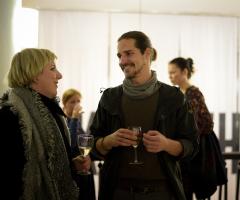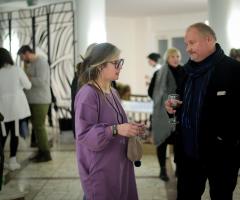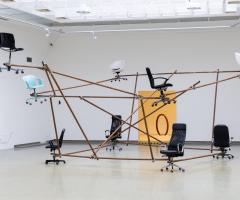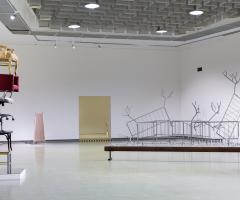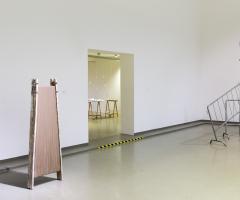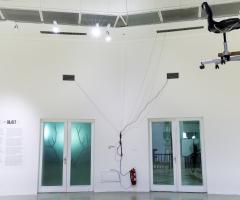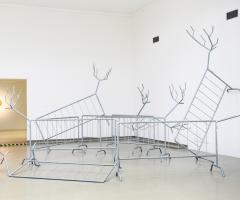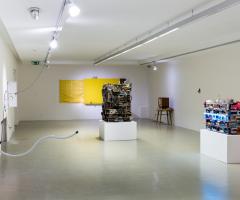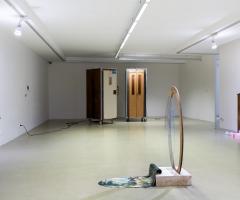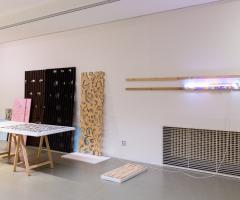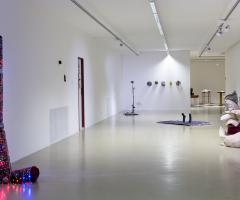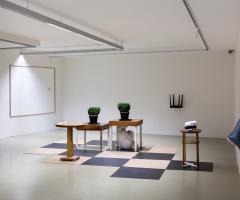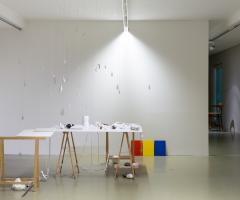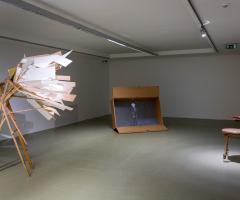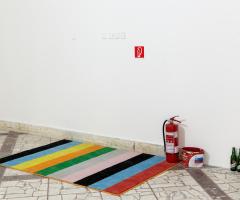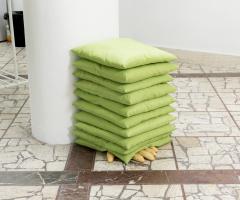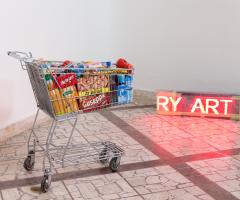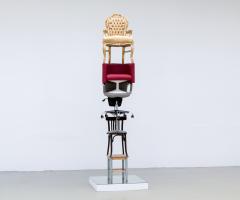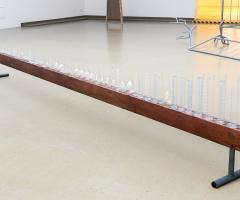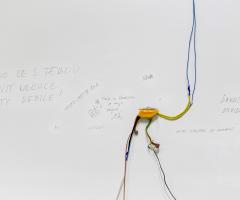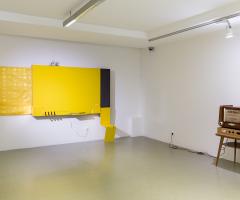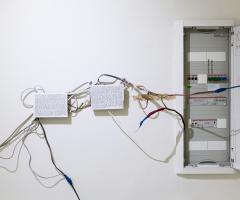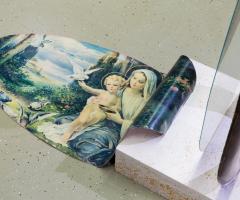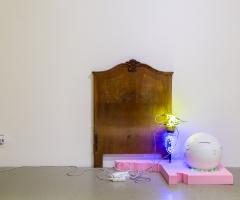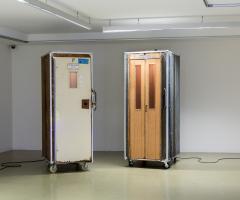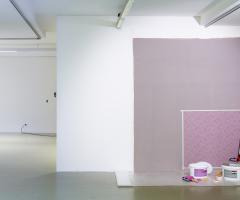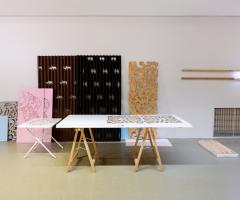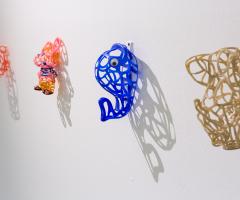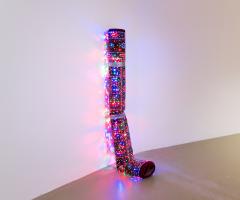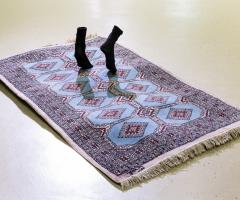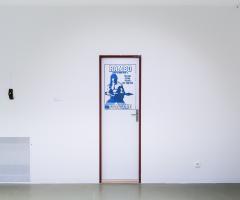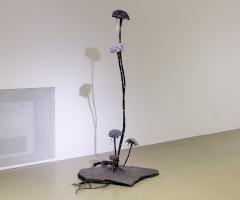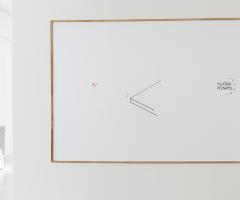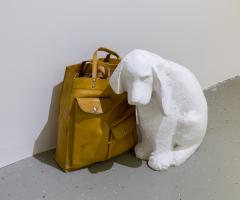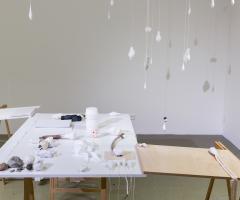OBJECTive
1st floor of KHB
Exhibition view // Photo © archive of KHB / Jakub Jančo
Opening:
November 29th 2018
from 6 p.m. to 8 p.m.
Duration:
November 30th 2018 - February 24th 2019
Venue:
1st floor KHB
Exhibiting artists: Jiří Černický (CZ), Viktor Frešo (SK), Krištof Kintera (CZ), Dominik Lang (CZ), Marek Kvetan (SK), Denisa Lehocká (SK), Roman Ondak (SK), Pavla Sceranková (SK/CZ), Tomáš Vaněk (CZ)
Guests: Peter Rónai (SK), Jiří Kovanda (CZ)
- - - - -
A Brief Report on a Meeting of Objects
The exhibition project entitled OBJECTive, now being premiered in Kunsthalle Bratislava, concentrates on mapping the state of current 3D thinking on the Czech and Slovak visual art scenes. Principally the aim is to confront and lend support to the current form of the object (including installations), as a distinctive mode of thinking in space and of the non-figurative language of forms and shapes and their significant contexts. The exhibition focuses on the generation of artists who entered upon the visual art scene after the change of regime (i.e. post-1989) and today figure in a wider Central European context. These artists were mostly born in the 1960s and 70s: to be precise, between 1966 (Černický, Ondak, Vanĕk) and 1980 (Lang, Sceranková).
Characteristic in their art is a preference for postconceptual procedures, a critical and ironic or simply humorous reflection on the contemporary world, hybrid and fragmentary as it is. This art shows a picture of contemporary days as unsettled, trembling and “nervous”. Hence the works tend to use non-classical sculptural materials, found and cast-off objects, and the aesthetic of “post-socialist” recycling and memory (old and worn furniture, electro-installations, particleboard, plaster, polystyrene and polyurethane, the aesthetic of the handyman, DIY, and so on).
The poetics of materials, and bastard environments, in absurd encounters: that is what the exhibition is about. Installation is reminiscent of the disorderly system of a scrapyard, an abandoned bazaar, or some weird collection from the past. Everyday found objects are placed in new relationships and connections. There are combined and hybrid objects and states: asphalt-cable flowers from the urban “post-nature zones” (Cerebrum Asphaltum, 2017) by Krištof Kintera; odd spatial patterns by Tomáš Vanĕk cut out from plastic toys and rubber balls (Participle No. 17, 2001); a bizarre object by Viktor Frešo made up of a plastic container for vegetables, an old TV screen, a painted head, loading straps, and a forceful gesture in black paint brushed directly onto the wall (Object O1 from the series Overheads, 2017). Added to these are some small moments Sceranková’s incision made in a hand by a silver ring (Happiness, 2018); a plaster dog waiting by a vintage shopping bag, by Lang (Dog, 2015); Kvetan’s white shoes, placed in the interior of a glittering bijouterie (Reliquary, 2014), or Denisa Lehocká’s introverted pictorial diary with a fragile network of ephemeral situations. These inconspicuous stories and shiftings of elementary materials often change the entire significance of the posited cultural situation and the possibility of reading it. At the same time, there is a kind of resistance to bombastic and spectacular installations. This register of contemporary forms of objects also includes interventions, occupation, or dwelling in the entire space: from the aggressive electrical leads, parasiting on a real electrical lead (Bonds, 2004/18) by Jiří Černický, through Sceranková’s expansive dancing office chairs on steel scaffolding (Constellations, 2013/18), to Denisa Lehocká’s intimate stories of crowded objects.
A distinctive chapter features objects and installations which sketch the atmosphere of a domestic room, the interior, folding furniture, or the “idiot” aesthetic of domestic masters and handymen in the “Do It Yourself” style. There is a striking hobby installation by Marek Kvetan from polystyrene and particleboard, featuring ornaments with motifs of children, deer, fairies, and the heroic Rambo “burned” onto all materials (Hobby III, 2010); Kintera’s “Van Gogh-style” clogs, embedded in concrete (Me Waiting In Another Room, 2009); Frešo’s head of a grandmother-style bed in a dim light, polystyrene, and his own mongoloid head (Recycle Me, 2017); and Sceranková’s Thonet chair, whose legs are “set” in fruit jars (Research, 2015). Filling in the sonic residue of old times is Černický’s interactive object, which, responding to the current movement of the viewer, retunes old news reports from the past (Anachronistic Radio, 2014/16). Finally, Kvetan’s insouciant installation brings us a symbolic linking of the global and the living-room worlds (Here in Our... II, 2010/18). This is a computer mixing of the colours of the national tricolours of Slovakia and Hungary, with the Hungarian mix-colour painted on the wall and an un-modern, flower-bedecked roller mixed from the Slovak colours overlain upon it. Equipment and paint pots are left lying around, as if the painter had just this minute run away...
We can further pursue the research field opened up here, with its preference for the aesthetic of cheap materials in former Czechoslovakia, thetower-block culture of bareness and aluminium rods, and a certain quotient of “Ost-algia”, transmitted to the present day. Through a series of objects, the exhibition thus communicates its own objective of setting and photo-shooting the world. Hence there is not just a distinctive “clash of materials” from high and low culture, but also “a clash of culures and galaxies” in the Sunday living room. We follow micro-events in the “sentimental” glued structures of Jiří Černický (Slumhouse, Kioskhouse , 2015); Kintera’s small sculpures and shopping baskets leaking polyurethane matter through their entire extent (Inside in Outside, 2017); Frešo’s old discarded lifts on wheels (Elevator, 2015) and weird objects composed from vinyl pipes, particleboard and builders’ foam (Untitled, 2014/18). Finally, we come to a trial-and-error dance of laboratory vessels with heads broken off on a beam (Trial and Error, 2018) by Roman Ondak, and a more complex installation by Dominik Lang: on a metaphorical chessboard there is an intensive conversation in progress between old side-tables, flowerpots, cast-off gloves, plaster casts of hands, and a squealing little girl hunched under a table. There is only a momentary flash of a human figure, before it is once again swallowed up by the remainder of its wretched environment (Difficulties of the Chess Composer, 2015). A black-and-white video is projected into Sceranková’s large overturned particleboard wardrobe; the video shows little ping-pong balls hitting the artist, like unpleasant questions, or the impacts of present-day items of information (Measuring, 2015).
This laboratory environment of singular, scattered objects manages overall to reflect the contemporary global world, the “crossing” of cultures in the socio-political system and in the public (media) space. An example might be Kvetan’s sound-light object of an unwrapped carpet propped against a wall (Carpet II, 2015). This is a commonplace IKEA Persian carpet, from which the voice of Tarkan, an Arab-pop Turkish singer from Germany, rings out. Kintera’s paradise of objects presents mobile steel barriers which are meant to limit and separate street space; they acquire playful antlers and create a “general meeting” without impediments – a paradisial encounter with mutual delight (Paradise Now, 2009). Ondak’s small “viruses”, disseminated throughout the entire exhibition, represent the intervention of almost twenty rucked-up remnants of copper roofs, painted in the two, three, or four colours of autonomous and separatist areas in Europe from Catalonia to Donbas (Autonomous Colours, 2018 ). Further, adding to his older work with a fluttering black plastic sack (Black Flag, 2011), Kintera provides some flags that are more colourful and (thanks to a ventilator) trembling – visions of better times to come (Flags of Better Future, 2017).
At the beginning and end of the exhibition there are invited special guests, two renowned artists who are a generation older and more experienced: Jiří Kovanda and Peter Rónai. However, they have not been admitted to the exhibition’s “hall of fame” but must remain ante portas – before the gate to this world, the entrance hall, under the Kunsthalle stairs. Much as we are received in western cultural practice. Usually they deal with us in the vestibule, and after the obligatory coffee they ask us when our next train home is leaving... The Czech intermedia artist Jiří Kovanda mainly recycles objects and things from the background and stores of the gallery. With small gestures and interventions, he returns them to artistic circulation. The multimedia artist Peter Rónai recycles his older works and readymades, with the active involvement of the viewer, and models his “de-installations”. So then, this is not about some powerful artistic nude descending the stairs, but rather a strange intimate meeting of objects under the stairs, in touch with the space and the hinterground of the gallery.
The project sets itself the ambition of showing the affinity in sculptural thinking and the common cultural heritage of a generation of impressive artists in the symbolic year 2018. On the centenary of the birth of the First Czechoslovak Republic, we are thus celebrating a tradition, over a century old, of object art as a new medium. It is demonstrated that the current from Duchamp’s fountain is still to this day, in the form of a badly insulated wire, making and forcing its way through, and the seat of Picasso’s bull’s-head bicycle shakes its head incredulously and marvels that the wheel of the world is nonetheless turning on the kitchen table...
Vladimír Beskid
Exhibition curator
- - - - -
- - - - -
Exhibiting artists:
JIŘÍ ČERNICKÝ (*1966, Ústí nad Labem, Czech Republic) Czech visual artist. He studied at the Academy of Fine Arts and the Academy of Arts,Architecture and Design in Prague and the Faculty of Education in Ústí nad Labem. His works are replete with transformed expression, intense gestures and ironic humour. All of his artworks conceal a powerful story both in content and expressive devices. A continuous thread of childlike astonishment runs through all of his artworks and expresses his desire for open communication, sometimes to the point of confrontation. It is precisely the two components of Černický’s strategies for artistic expression, which allow him to seemingly search for and detect the dominant currents in contemporary society. Černický is the winner of the Jindřich Chalupecký Prize (1998). He lives and works in Prague.
VIKTOR FREŠO (*1974 Bratislava, Slovak Republic) Slovak conceptual artist, photographer, painter, sculptor and musician. He studied at the Academy of Fine Arts and Design in Bratislava and at the Academy of Fine Arts in Prague. Frešo is one of the most remarkable figures of the contemporary art scene in the region of the former Czechoslovakia after the year 2000. His work and overall approach to art is rather untypical but at the same time reflects the situation in society and culture. The artist creates sophisticated concepts and projects, presenting them as seemingly simple closed “Pieces of Art”. He is often critical in his works and aggressively expresses his contempt for the art scene and its processes, but with a light, humorous and playful undertone. One of the most fascinating elements of his creation is the seeming counterpoint of emphasis on the huge, grandiose EGO connected with the Gesture in combination with disarming self-ironic humility. Whether he intervenes in the public space or exhibits in galleries, he takes care that an immediate creative action shows itself in the execution – GESTURE. Another very typical aspect is the interference into the world of media where without any respect he publicly presents his radical and often disrespectful opinions. Recently, among other things, the artist has devoted himself to sculpture and painting.
MAREK KVETAN (*1976, Bratislava, Slovak Republic) Slovak video, installation and multimedia artist. He studied at the Academy of Fine Arts in Bratislava in the studios of Prof. Fischer and Prof. Bartusz. Kvetan is concerned with multimedia work (video art, installation, new media, public art) characterised by distinctive neo-conceptual thought and a great sense of experimentation. Kvetan works with the strategies of manipulation, transformation and appropriation. He was one of the initiators of the establishment of the Central European Institute for Contemporary Art CEICA, Dart magazine, Multiplace festival and the international network Billboart Gallery Europe. Kvetan is the winner of the NG 333 Prize, the Novum Foundation Award, and the finalist in the competition for the Henkel Art Award. He lives and works in Bratislava.
DOMINIK LANG (*1980, Prague, Czech Republic) A Czech sculptor. From the very beginning of his artistic practice, he has reflected on the ways artworks are presented, taking into account the history of the exhibited artwork, the social, political and economic context that surrounds it as well as its integration with architectural design. Lang does not perceive exhibition spaces as mere (mute) background, but as elements that play an active role in the perception of an artwork and expression of its meaning. He often reveals the hidden mechanisms of artistic production as well as that of the functioning of institutions, trying to find new forms of institutional critique (exemplified in several large-scale projects responding to the situation of the National Gallery in Prague, the memory of the big fire as well as a lack of communication and productivity of its employees). In 2011 Dominik Lang represented the Czech Republic at the Venice Biennale, turning the Czechoslovak pavilion into his Sleeping City installation. Dominik Lang is the head of the Sculpture Studio at the Academy of Fine Arts in Prague. He designs architectural concepts of exhibitions combining his artistic practice with that of an architect, creating installations or spatial arrangements that present exhibited works and offer a new context for their interpretation. He lives and works in Prague.
DENISA LEHOCKÁ (*1971 Trenčín, Slovak Republic) Slovak fibre artist. She studied in the Department of Textiles at the School of Applied Arts and then pursued her studies at the Academy of Fine Arts in Bratislava (Open Studio of Rudolf Sikora). Lehocká arrived on the art scene in the 1990s together with a strong post-revolution generation of artists (Roman Ondak, Boris Odreička, Cyril Blažo, to name but a few) who were preoccupied with an urgent solution to the relationship between the legacy of Conceptual art and the difference between its western and eastern variants and themes. In the following years, Denisa Lehocká devoted herself to the themes and practices that are not unambiguous and especially “female”, but have appeared in the work of some prominent representatives of fibre art in the last fifty years – a careful thought about fragile materials, time-consuming processual work, the themes of composing the body from cultural and material organs and the like. She also exhibited at Manifesta 3, Kunsthalle Basel, Kunsthaus Bern, ITCA International Triennial, Austrian Cultural Center in New York, Mumok in Vienna, New Museum Hub in New York, among others. In addition to private collections, the artist’s works are included in the collections of the Slovak National Gallery, Erste Bank: Kontakt (AT), European Investment Bank (LU), Societé Generale and The Florence & Daniel Guerlain Collection (FR). She lives and works in Bratislava and Vienna.
KRIŠTOF KINTERA (*1973, Prague, Czech Republic) Czech artist and sculptor. He studied in Milan Knižák’s studio at the Academy of Fine Arts in Prague and subsequently at the Rijksakademie van beeldende kunsten in Amsterdam. Kintera was head of the Sculpture II Studio at the Academy of Arts, Architecture and Design in Prague. He was co-founder of the Skrytá tvůrčí jednotka (Undercover Art Unit), a grouping of artists engaged in various activities, from performance to theatrical productions. In his art he focuses mainly on objects and installations, using electronic and mechanical items, banal and kitsch objects of everyday reality. He approaches his works and materials with an ironic, humorous detachment, selecting freely from everything and everywhere. His works are represented in the Modern and Contemporary Art collections of the National Gallery in Prague, Ludwig Museum in Budapest, Museum der Moderne in Salzburg, Fogg Art Museum of Harvard University in Cambridge, Olbricht Collection in Berlin, and Jerry Speyer Collection in New York, among others. Krištof Kintera has exhibited in such world renowned galleries as the Galerie Schleicher+Lange in Paris, Jiri Svestka Gallery in Berlin, Václav Špála Gallery in Prague, Moderna Musset in Stockholm, Royal College of Art in London, The National Museum of Art in Osaka, Art Rock in New York, to name but a few. He has been nominated three times for the Jindřich Chalupecký Prize. He lives and works in Prague.
ROMAN ONDAK (*1966, Žilina, Slovak Republic) Slovak conceptual artist. He is currently regarded as one of the most prominent representatives of neo-conceptual strategies. His unusual artistic concept has made him one of the most prominent artists of the last decade. In his visual work Ondák innovatively uses the reality of the world by staging and contextual shifts. The spectators are attracted by repeated contradictory shifts of meanings in the places where something stereotypical is expected. This particular quality of variability of his works and installations strongly appeal to the spectators. Ondák was awarded a DAAD grant in Berlin for 2007 and 2008 and presented his projects at numerous solo exhibitions, among others in Cologne’s Kunstverein, Tate Modern in London, Pinakothek der Moderne in Munich, the Wattis Institute for Contemporary Arts in San Francisco and the Museum of Modern Art in New York. He is the winner of Best Artist of the Year, Deutsche Bank, Lovis Corinth Prize and a few others. He lives and works in Bratislava.
PAVLA SCERANKOVÁ (*1980, Košice, Slovak Republic) Slovak intermedia artist. She studied at the Academy of Fine Arts in Prague, where she also completed her doctoral studies in 2011. Together with Dušan Zahoranský, she runs the studio of intermedia art at the Academy of Fine Arts in Prague. She creates sculptural objects and installations characterised by their minimalist purity and sensitive relation to a particular place. Another aspect of her works is demonstrated in the creation of objects with an element of action prompting the spectators to interact. As to the level of content, Pavla Sceranková is concerned with the reflection of human perception, memory and individual experience of the surrounding world. She has put on several successful exhibitions at reputed galleries, for instance the Drdova Galerie in Prague; EFA Project Space in New York; Wroclaw Contemporary Museum in Wroclaw; Galerie Rudolfinum in Prague; Astrup Fearnley Musset in Oslo, among others. In 2015 Pavla was nominated for the Jindřich Chalupecký Prize. She won the Václav Chad Award at the Zlín Salon of Young Artists in Prague in 2009, and the Cyprian Award at the Trnava Biennial in 2007. Her works can be found in numerous public collections, including the National Gallery in Prague; Slovak National Gallery in Bratislava; Prague City Gallery, and a number of private European collections. She lives and works in Prague.
TOMÁŠ VANĚK (*1966, Počátky, Czech Republic) Czech intermedia artist. He studied at the Academy of Fine Arts (AVU) in Prague in the studios of Jiří Sopka and Vladimír Kokolia. Vaněk ran the studio of Intermedia at the AVU. Since 2014 he has been Rector of the Academy of Fine Arts. He arrived on the Czech art scene in the mid-1990s and brought art into public spaces. Vaněk is the winner of the Jindřich Chalupecký Prize (2001). He represented the Czech Republic at Manifesta 8 at the European Biennale of Contemporary Art. He is a member of two art groups: Bezhlavý Jezdec (Headless Rider together with Josef Bolf, Jan Mančuška and Jan Šerých) and PAS – Production of Present Activities (together with Jiří Skala and Vít Havránkek). He also initiated the project for a shop window exhibition in one of Prague streets together with the group Bezhlavý jezdec. It was a contrast between artistic practices and the daily life in the street. He is still concerned with direct communication experiments in realistic conditions today.
Guests:
JIŘÍ KOVANDA (1953, Prague, Czech Republic) Czech self-taught artist. “What I have been doing is derived, above all, from the effort to focus on the perception of the present moment and on what surrounds us. If possible, I do it without hierarchizing, without sorting out things to those important and unimportant. My work is based on immediate experience and knowledge and skills, and it often depends on casual encounters. I usually don’t know what the next exhibition is going to look like... And this is actually my goal – I make an effort to keep myself in a vigilant state and respond to what is happening now, allowing myself to be surprised. Because art is not about watching something the artist has achieved, what he already knows but on the contrary it opens up the possibilities for sharing and experiencing what is coming.” (Kovanda, 2018)
PETER RÓNAI (*1953, Budapest, Hungary) Slovak multimedia artist. He studied at the Academy of Fine Arts in Bratislava (until 1974) and continued studying at the Academy of Fine Arts in Budapest (until 1976). He was teaching at several art schools and universities (UKF in Nitra; Faculty of Visual Arts, Brno University of Technology; UCM Faculty of Mass Communication in Trnava). Rónai is currently the head of the Department of Fine Arts and Intermedia at the Faculty of Arts of the Technical University in Košice. Together with Milan Adamčiak and Július Koller they founded the association Nová Vážnosť (New Seriousness). “He is still perceived as one of the founders of Slovak Video art and a creator of post-photography and specific collages (rónaiograms). His early pictures/ objects represent a very relevant group of works that can be considered a manifesto of Rónai’s work of the 1990s, but also one of a few polemics or oppositions raised against the neo-avant-garde...” (Gregor). Selected group exhibitions include: Der Riss im Raum – Gropius Bau, Berlin; Esperanto – Werkgalerie Kassel X. Documenta Frame Program, Kassel; Aspekte und Positionen 50 Jahre Kunst – Ludwig Museum, Vienna; Here and Now, Műcsarnok, Budapest; MAPS Save as, Ludwig Museum, Budapest. His work is included in the galleries and collections of the Slovak National Gallery, Bratislava; Ludwig Museum Budapest; National Gallery, Prague; Documenta archive Kassel, MoMA New York and many others.
Curator:
VLADIMÍR BESKID (*1962, Semiduby, Ukraine) is a Slovak art historian, curator and cultural manager. He graduated from the Philosophical Faculty of Comenius University in Bratislava (1985). He engages in research, presentation of research, and presentation of modern and contemporary art of the 20th and 21st centuries in the wider Central European context. Vladimír Beskid has published high-level studies and articles on these questions (e.g. The Situation of Visual Culture in Post-War Slovakia. In: IRWIN (edit.): EAST ART MAP – Contemporary Art and Eastern Europe; Afterall Books and The MIT Press Cambridge 2006). He is the co-founder of the Department of Visual Arts and Intermedia at the Arts Faculty of the Technical University in Košice, where he also taught (1998 – 2002). Since 2012 he has been co-organiser of the international festival Sound City Days/Mesto zvuku in Košice. As curator he has prepared over 80 exhibitions of contemporary art in Slovakia and abroad. In recent times he has concerned himself with the development of Slovak (post)conceptual art (exhibitions include Soft Codes, Contemporary Museum,Wroclaw, 2015; Reversed, Museum of Contemporary Art, Nový Sad 2016; Probe 1, GHMP Prague, 2018). He lives and works in Trnava, Bratislava and Košice.
- - - - -
Photo ©
/ exhibition: Jakub Jančo
/ press conference and opening: Ema Lančaričová



